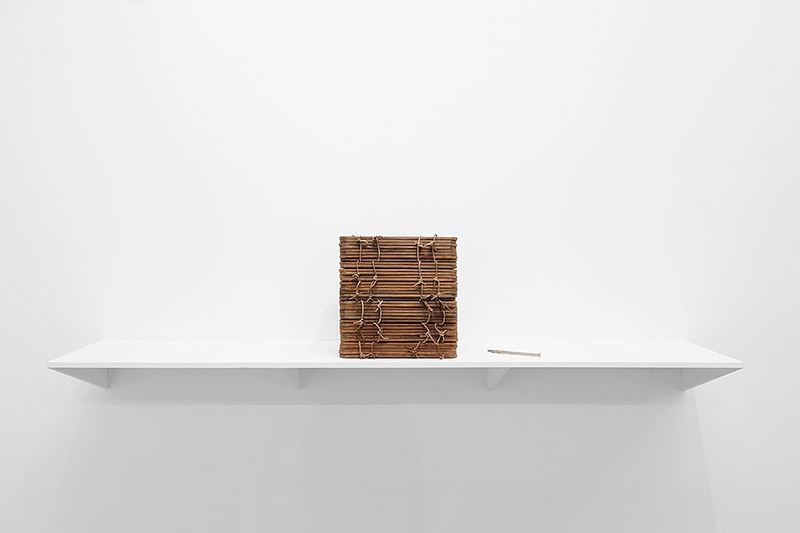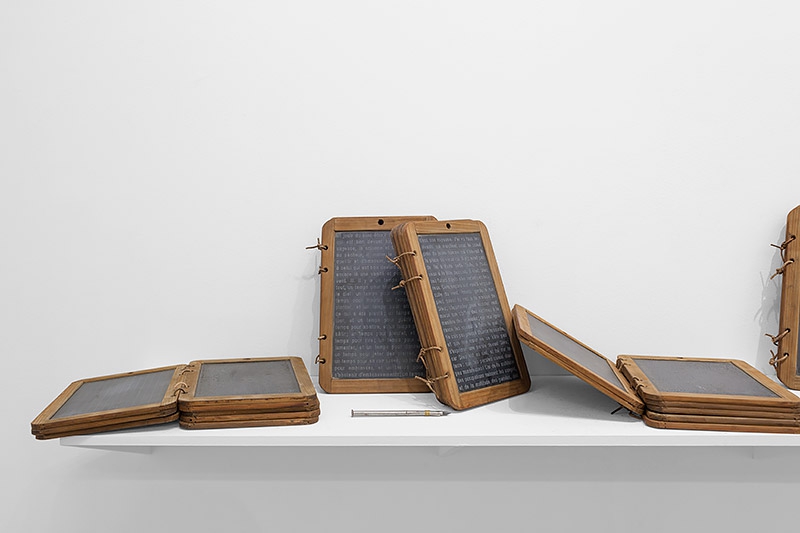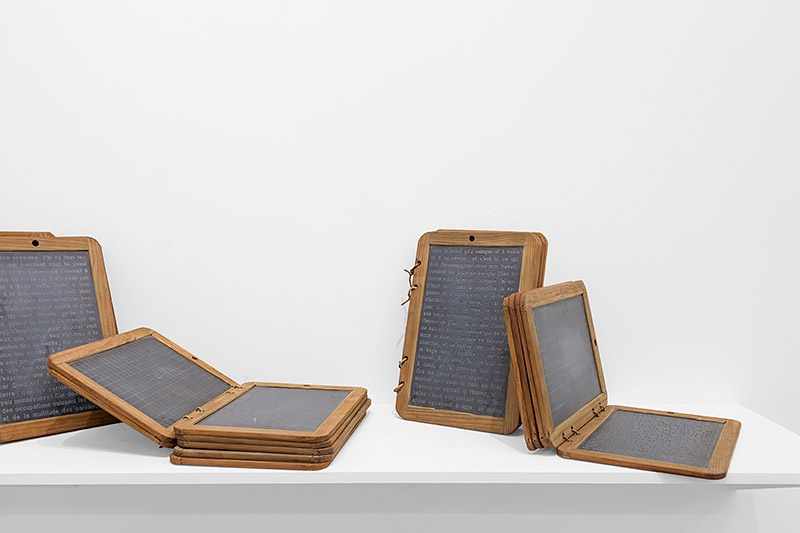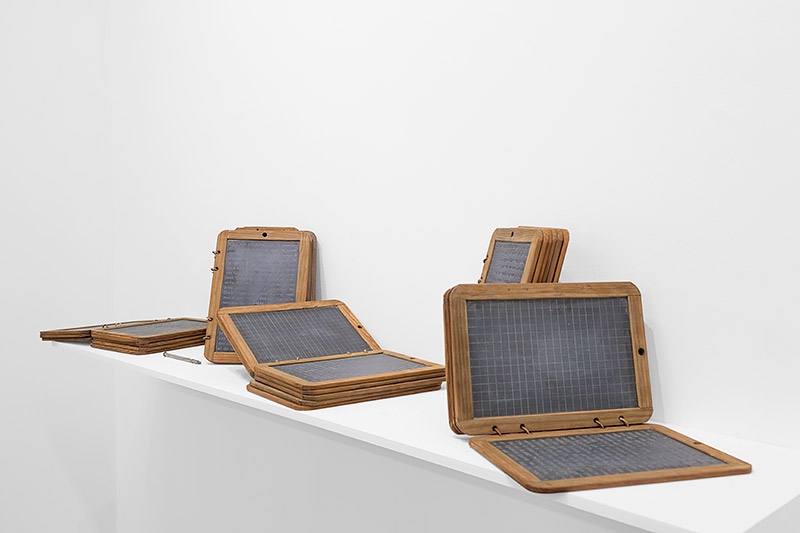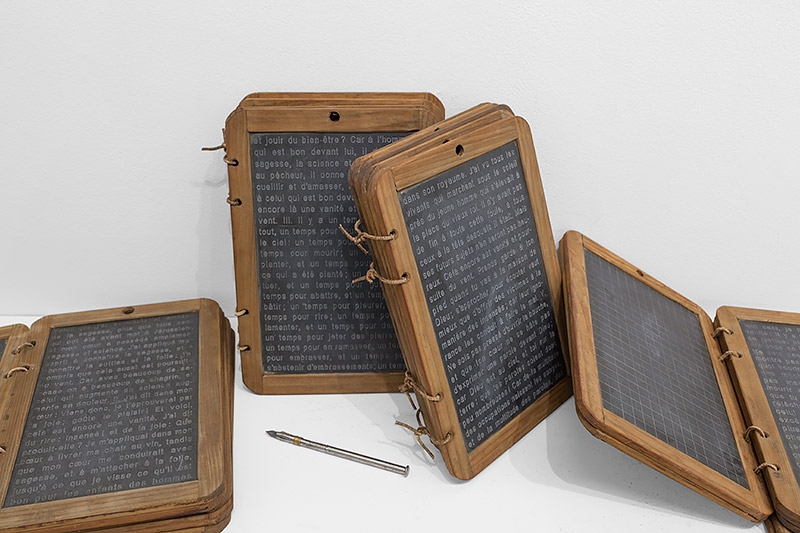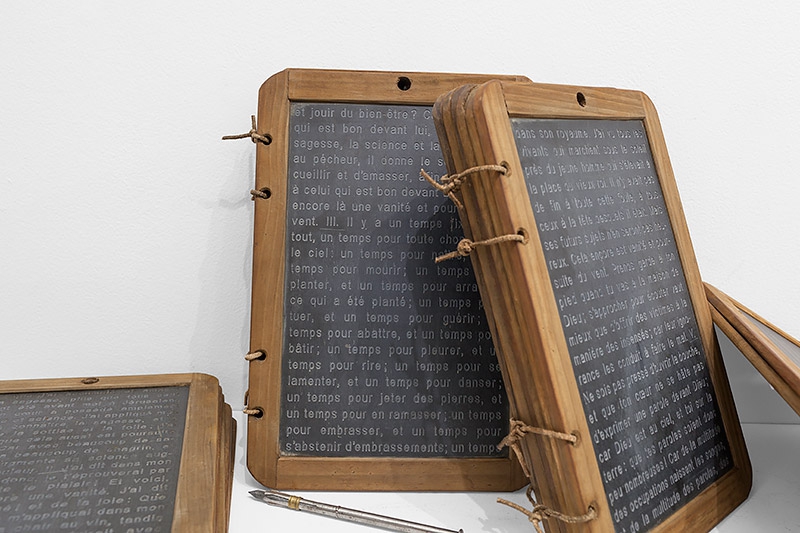No man is an island entire of itself;
every man is a piece of the continent, a part of the main.
John Donne, Devotions upon Emergent Occasions, (1624)
-
Like the bee gathering honey from many blossoms, those who aspire to be sages must take something of wisdom from all the scriptures - both the great and the small.
Uddhava Gîtâ, The final teaching of Krishna
-

School slates engraved with a text using CNC (digital milling), and bound together to constitute a book made out of stone. The text can easily be viewed and read, and cannot be erased (or with difficulty); the first book to be produced of the soon-to-be library is
The Ecclesiastes (a book of the Bible).

This work is anchored in concerns surrounding the destruction of books and of knowledge, and proposes a reflection as to the possibility of an eternal book; since both books and knowledge can disappear altogether, the goal of this piece is to produce an indestructible library.

Texts, unlike most images, can be timeless: if its author or its era are unknown, the accurate dating of a text can be nigh on impossible. One of the most striking examples of this phenomenon is the ‘literature of wisdom’ that emerged during the first classical age and which consisted of advice given by a sage or an elder person to a younger person. Considering that humanity has changed little over thousands of years, these texts have remained valid and ring true even today. Such observations were the basis for this project, which aims to contribute to the preservation of the parts of human thought known in ancient Greece as ‘phronesis’, a term which could be translated as ‘prudence’ or ‘attention’. It is worth noting that this current of thought is not linked to religion, in any civilization.

A stable material support where writing can be eternally preserved has yet to be found: clay, parchment, papyrus, paper, plastic and electronic data all share the same shortcoming. Stone is technically the strongest support – it can be broken, but inscriptions are hard to erase – although it is perhaps the least practical. With the notion of learning at the heart of this project, one material seemed particularly apt for its realization: slate. It is no coincidence that modern digital tablets have, by and large, the same dimensions as a school slate: this project is both human in scale and much vaster by virtue of its boundless encyclopaedic ambition. It raises the question of the eternal protection of knowledge in the face of the accepted notion that “all is vanity and striving after wind” (
Ecclesiastes). Such contradictions are – and always will be – part of human existence.
 Digital milling on school slates (slate, wood, leather strings)
Digital milling on school slates (slate, wood, leather strings)
Variable dimensions

Nul n’est une île, un tout en soi;
chaque homme est partie du continent, partie du large.
John Donne, Devotions upon Emergent Occasions, 1624
-
De tous les traités, autant des grands que des petits, l’homme avisé fera son miel, tout comme une abeille extrait des fleurs le nectar.
Uddhava Gîtâ, Les Dernières paroles de Krishna
-

Des ardoises d’école gravées d’un texte en CNC (fraisage numérique). Elles sont et reliées pour former un livre de pierre facilement lisible et consultable, dont le texte ne peut pas être effacé (ou difficilement). Le premier livre à être réalisé de cette future bibliothèque est l'Ecclésiaste (chapitre de la Bible).

« Nul n’est une île » est un projet encyclopédique sur l’apprentissage, la sagesse humaine et sa préservation. Il découle de préoccupations sur la destruction des livres et des connaissances, et vise à proposer une réflexion sur la possibilité d’un livre éternel. Les livres et les connaissances pouvant disparaître définitivement, son but est la production d’une bibliothèque indestructible.

Un texte, contrairement à beaucoup d’images, peut être intemporel : si nous ignorons son auteur ou son époque, il ne peut être daté avec précision. Un des meilleurs exemples est la « littérature de sagesse », un genre qui a émergé dans la première Antiquité, avec des conseils donnés par une personne âgée et /ou sage à quelqu’un de plus jeune. Considérant que l’humanité n’a pas beaucoup changé au cours des derniers milliers d’années, ces textes peuvent pratiquement parler à n’importe qui à n’importe quelle époque. Sur la base de ces observations, ce projet a prévu de contribuer à la préservation de cette partie de la pensée humaine appelée «phronisis» dans la Grèce antique, traduite par « prudence » ou « attention ». Il est à noter que cette notion est peu liée à la religion.

Un support stable où l’écriture peut être éternellement préservée n’a pas encore été trouvé. L’argile, le parchemin, le papyrus, le papier, le plastique ou les données électroniques partagent tous une déficience inhérente. La pierre est techniquement le support le plus fort (cassable mais complexe à effacer), bien que le moins pratique. En relation avec l’idée d’apprendre au cœur du projet, un matériau « parfait » est apparu : des ardoises scolaires. Ce n’est pas par hasard que les ardoises et les tablettes numériques ont les mêmes mesures: ce projet est à taille humaine, mais son ambition encyclopédique sans début ni fin change son échelle. Il pose la question d’une protection éternelle de la connaissance alors que « tout est vanité et poursuite du vent » (Écclésiaste). Mais ces contradictions supposées font partie de la vie humaine — à jamais.

Fraisage numérique sur ardoises d’école (ardoise, bois, cuir)
Taille variable


